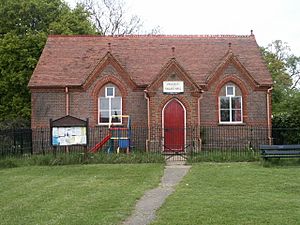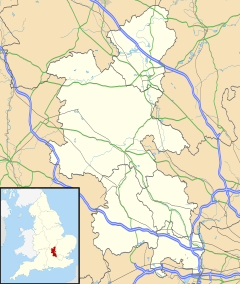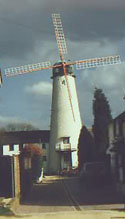Cholesbury facts for kids
Quick facts for kids Cholesbury |
|
|---|---|
 Cholesbury Village Hall |
|
| OS grid reference | SP930070 |
| • London | 28 mi (45 km) |
| Civil parish |
|
| Unitary authority |
|
| Ceremonial county | |
| Region | |
| Country | England |
| Sovereign state | United Kingdom |
| Post town | Tring |
| Postcode district | HP23 |
| Dialling code | 01494 |
| EU Parliament | South East England |
| UK Parliament |
|
| Website | [1] |
Cholesbury is a small village in Buckinghamshire, England. It's right on the edge of Hertfordshire. Long ago, in the 1200s, it was called Chelwardisbyry. You'll find it nestled in the beautiful Chiltern Hills. It's about 4 miles east of Wendover and 5 miles north of Chesham.
Cholesbury is one of four villages that make up the larger area called Cholesbury-cum-St. Leonards parish. A tiny nearby settlement, Braziers End, has always been a close part of Cholesbury. Most people living here work in nearby towns or even in London. They also use modern internet technology to work from home.
| Top - 0-9 A B C D E F G H I J K L M N O P Q R S T U V W X Y Z |
Exploring Cholesbury's Landscape
Cholesbury is one of the smallest villages in Buckinghamshire. It covers about 178 acres. The village sits on a high plateau in the Chilterns. It's close to a steep chalk slope that looks over the Vale of Aylesbury. At its highest point, the village is about 650 feet above sea level.
What's Under the Ground?
The type of land in Cholesbury is shaped by its geology. The soil is mostly clay mixed with gravel. You'll also find small stones and oolite over a chalk layer. Interesting rocks called puddingstones are found here. These are a special type of rock made of pebbles cemented together.
There are no streams because the chalk ground soaks up water quickly. But in some spots, clay near the surface creates natural ponds. These ponds are fed by springs. Before homes got connected to main water pipes in the mid-1900s, people relied on deep wells and collected rainwater.
How Land is Used Here
Unlike other parts of the Chilterns, Cholesbury has lots of open space. This includes farms for crops and animals, horse paddocks, and heathland. The most important open space is the Common. Most houses are built along its edges.
The village also has many old trees. A group of beech trees marks the edge of an ancient hillfort. Some beech forests remain from when they were used for the chair-making industry in High Wycombe. In the past, people dug out chalk and a little clay from the ground. Clay was used for pottery and later for making bricks. Flint was also dug up for building roads. These activities left small hills and dips in the land.
Years ago, many homes had orchards and gardens. People grew vegetables and kept farm animals. Most of these have disappeared. Recently, horse riding has become popular. This has created a demand for land to use as paddocks.
Village Life and Homes
Villages in the Chilterns often grew around village greens or along ridges. Cholesbury is connected to nearby villages like Hawridge, St Leonards, and Buckland Common. The small settlement of Braziers End is very close to Cholesbury. It's said that its name comes from fires lit by Travellers. They used to gather there for celebrations.
Until 1935, Cholesbury didn't have main water pipes. Drainage systems didn't arrive until 1963. The road to Chesham was often blocked in winter. Even recently, there have been floods. During the Second World War, many people moved here to escape the London Blitz. Many stayed after the war. This led to more houses being built or made much bigger.
From the 1950s, better transport made it easier to travel to London for work. This brought more well-off families to the village. This changed the community a lot. In the 1960s, people worried about too much building. They formed groups to protect the village's look. Cholesbury is in the Chilterns AONB (Area of Outstanding Natural Beauty). Strict rules control new building. This means there aren't many affordable homes. House prices in Cholesbury are very high compared to other places in South East England.
Cholesbury's Past
How the Village Began
The name Cholesbury comes from an old Anglo-Saxon word. It means 'Cealwald's burh' or 'plateau camp'. This name refers to an Iron Age hillfort called Cholesbury Camp. It's near the center of the village. Experts believe it was built between 300 and 100 BC. It might have been built on an even older settlement. A Bronze Age axe found nearby supports this idea.
The fort was mostly used for trading, not for fighting. There is proof of iron smelting there. Archaeologists found old hearths and waste from iron production. When the Romans arrived, the hillfort was not used for long. By the 2nd century, most people had left. They likely moved to valley settlements where Roman villas were being built. Later studies suggest people lived there again in early medieval times. An even older Palaeolithic hand axe was found in the 1960s.
Growth of the Manor and Village
In the time of Edward the Confessor, Cholesbury was part of a larger estate. The Domesday Book mentions it as 'Chowdesbury'. It was part of the Draiton manor. The hilltop area was good for summer grazing. It had reliable springs that fed ponds. The area was heavily wooded, enough to support 200 hogs.
At this time, Cholesbury was a small, temporary settlement. Over the next 150 years, a permanent hamlet grew. It remained part of the Drayton estates. In 1091, the land was given to the Knights Templar. When they were dissolved in 1312, it passed to the Knights Hospitaller. After this, Cholesbury slowly became a separate manor. It grew into a village community. An early 12th-century church was built inside the hillfort. It was dedicated to St Laurence. This is one of only two churches in the Chilterns built inside hillforts. The other is at West Wycombe.
By the time of Henry III around 1248, the village was big enough to become its own manor. The church was made larger with a porch. A resident parson named Abel was appointed. Around 1330, Thomas Perot became the Lord of the Manor. But Cholesbury's independence was short. In 1336, it was linked back to Drayton Beauchamp. Full independence finally came in 1541. Robert Cheyne sold the manor to Chief Justice John Baldwin.
In 1618, John Baldwin sold the manor to Thomas Stile. By 1650, the rights of the Lord of the Manor went to the Seare family. They also owned the manor in nearby Hawridge. Until the mid-1700s, Cholesbury was still just a small church area under Drayton Beauchamp. Cholesbury became its own church parish in 1756.
The English Civil War in Cholesbury
During the English Civil War, people in the Chilterns were unhappy. They disliked the Ship Money tax and the oath for the Protestation of 1641. These were some reasons for the fight between Parliamentarians and King Charles I. Like other villages, Cholesbury housed Parliamentarian troops. They fought in small battles with Prince Rupert near Chesham and Wendover.
Helping the Poor in the Past
Cholesbury played a small part in changing social policy in England. Since the time of Elizabeth I, property owners paid a tax to help the poor in their parish. This tax grew a lot in the 1700s and early 1800s. Life was very hard for people working the land in the Chilterns from 1812. The parish leaders could not collect enough money to help the poor. In 1832, they declared themselves bankrupt.
The Rev. Henry Jeston was the vicar from 1830. He wrote a report to Parliament about the parish's struggles. Between 1832 and 1835, he got enough loans from other parishes and landowners to save Cholesbury. He also put in place plans to make sure the parish would be financially stable in the future. He was mentioned in the debate that led to new laws for the poor. The village honored Jeston by raising money for a stained-glass window in the church.
Local Jobs and Businesses
Cholesbury was a crossroads for several droving routes. The Commons provided a safe place for animals to rest. This regular traffic supported local businesses. Several alehouses (pubs) operated over the years. By 1753, "The Castle," "The Maidenhead," "The Queen's Head," and "The Slip Inn" were open. They did well because of the increase in trade. They were also popular with brickyard and farm workers. None of these old pubs are still open today.
Before the 1900s, farming and woodworking were the main jobs. Work was often temporary. People also mended roads or picked fruit when orchards were common. Straw plaiting was the main job for women and children in the 1800s. The plaited straw was sent to Luton or London. Until the Second World War, farming was the biggest industry. In Chesham, people could find work in mills and shoe factories.
Clay deposits were found nearby. This led to small-scale pottery making since the 1600s. After the First World War, many new houses were needed. This caused brickmaking to grow fast. St Brown's brickworks opened in Shire Lane. It made millions of bricks each year. In 1946, another brick company, Dunton's, rented land nearby. They helped meet the demand for bricks to rebuild after the war.
Since the Second World War, less land is used for farming. But today, there are still many farms around the village. They grow crops and raise sheep. Better roads and public transport meant people could work further away. The railway came to Chesham in the 1880s. This made it easier to travel to London. Today, there are no big employers left in the village. The 2001 census showed more people in Cholesbury work from home.
Who Lives in Cholesbury?
In 1801, the census recorded 122 people in 25 families living in 22 houses in Cholesbury. The population dropped to 105 by 1861. It stayed around this level into the 1900s. In 1931, it was still only 115 people.
In 2001, most local people (93.5%) were recorded as White. Almost 80% said they were Christians. About 45% of people had jobs. A much higher number (21%) were self-employed. Over 15% were retired, which was slightly more than in nearby areas.
Famous People from Cholesbury
The Cannan family left the windmill in 1916. After them, the famous American actress Doris Keane rented it.
Danny Dunton was an English international motorcycle speedway rider. He also promoted races. He reached the final of the Speedway World Championship in 1950.
Important Places and Buildings
The Manor House dates back to the late 1500s. The Lord of the Manor held court there. It used to be much bigger than it is now. Many other old houses in the village also date from this time.
Cholesbury Camp is an Iron Age hillfort. It's a very important historical site. It's almost circular and covers about 10 hectares (25 acres). It has a double earth wall, or rampart. Houses break this wall on the south side. Long ago, a wooden fence made from thousands of trees would have stood on top of these earthworks. Today, a magnificent group of old beech trees marks the fort's edge.
Near the fort is a pond called the 'Holy' or 'Bury' pond. It's fed by a spring that never dries up, even in very dry times. The church of St Lawrence is also inside the hillfort. Cholesbury Common runs through the village on both sides of the road.
Other notable buildings include Cholesbury Windmill. It was first built in 1863 as a smock mill. But it was rebuilt in 1883 as a tower mill. Cholesbury Village Hall was built in 1895. Frederick Butcher, a banker, gave the land for it. He supported the Temperance movement. He believed in providing fun places for working men instead of just pubs. An outside shot of the village hall was used in the 2013 BBC comedy Up the Women.
The 'Full Moon' public house (pub) dates from the 1600s. It was known by different names before taking its current name in 1883. The Full Moon was where the Lord of the Manor of Hawridge traditionally held court. These meetings were mostly about using the commons, like grazing rights.
A stone monument stands on the border between Hawridge and Cholesbury. It was put up in 1898 to celebrate Queen Victoria's Diamond Jubilee. Nearby, three puddingstones were placed together in November 2012. This was to mark Queen Elizabeth II's Diamond Jubilee.
How Cholesbury is Governed
The old manorial rights from the 1100s no longer control village life. The Hawridge and Cholesbury Commons Preservation Society now manages the Commons. A Lord of the Manor still owns the Commons. The church vestry has been replaced by the parochial church council. This group focuses on church matters. Its responsibilities for the village are now handled by the parish council.
Cholesbury is one of four 'Hilltop Villages'. The others are Hawridge, St Leonards, and Buckland Common. Before 1934, Cholesbury was a separate parish. On April 1, 1934, it joined with the other villages. They formed the new civil parish of Cholesbury-cum-St Leonards. It also became part of the Amersham Rural District. In 1974, the Chiltern District took over.
Learning in Cholesbury
Before the National School opened in Hawridge in 1874, children learned in a straw plaiting school in the village. Children aged 5 to 11 go to Hawridge and Cholesbury Church of England School in nearby Hawridge. A private nursery school is located at Cholesbury Village Hall.
For older students, the local secondary schools are Chiltern Hills Academy and Chesham Grammar School in Chesham. Boys can attend Dr Challoner's Grammar School in Amersham. Girls can go to Dr Challoner's High School in Little Chalfont.
Getting Around
Almost 95% of local residents own a car. Over the years, bus services have greatly decreased. Today, a bus runs only once each way on certain days. It connects to Chesham, Tring, and local villages. School buses are very helpful. They take children to secondary schools in Chesham and Amersham.
Fun and Games
The cricket club started in 1885. They got permission from the Lord of the Manor to use the Common. The club is still very active today. Its First XI team plays in the Premier Division of the Morrant Chiltern League.
The local area is popular for outdoor activities. It has open views, quiet lanes, commons, and woodlands. Many footpaths and bridleways cross the area. This makes it great for cyclists, walkers, and horse riders.
The churches of Hawridge and Cholesbury hold a summer fair together. It happens on the August Bank Holiday Monday. It takes place on either Hawridge or Cholesbury Commons. The Vale of Aylesbury with Garth & South Berks Hunt traditionally meets on Boxing Day (December 26). This event brings a large crowd from the area. The Village Hall hosts events for local groups. These include the Horticultural Society, Local History Group, and Commons Preservation Society. It also hosts 'Cholesbury Teas' on Sundays during the summer.






